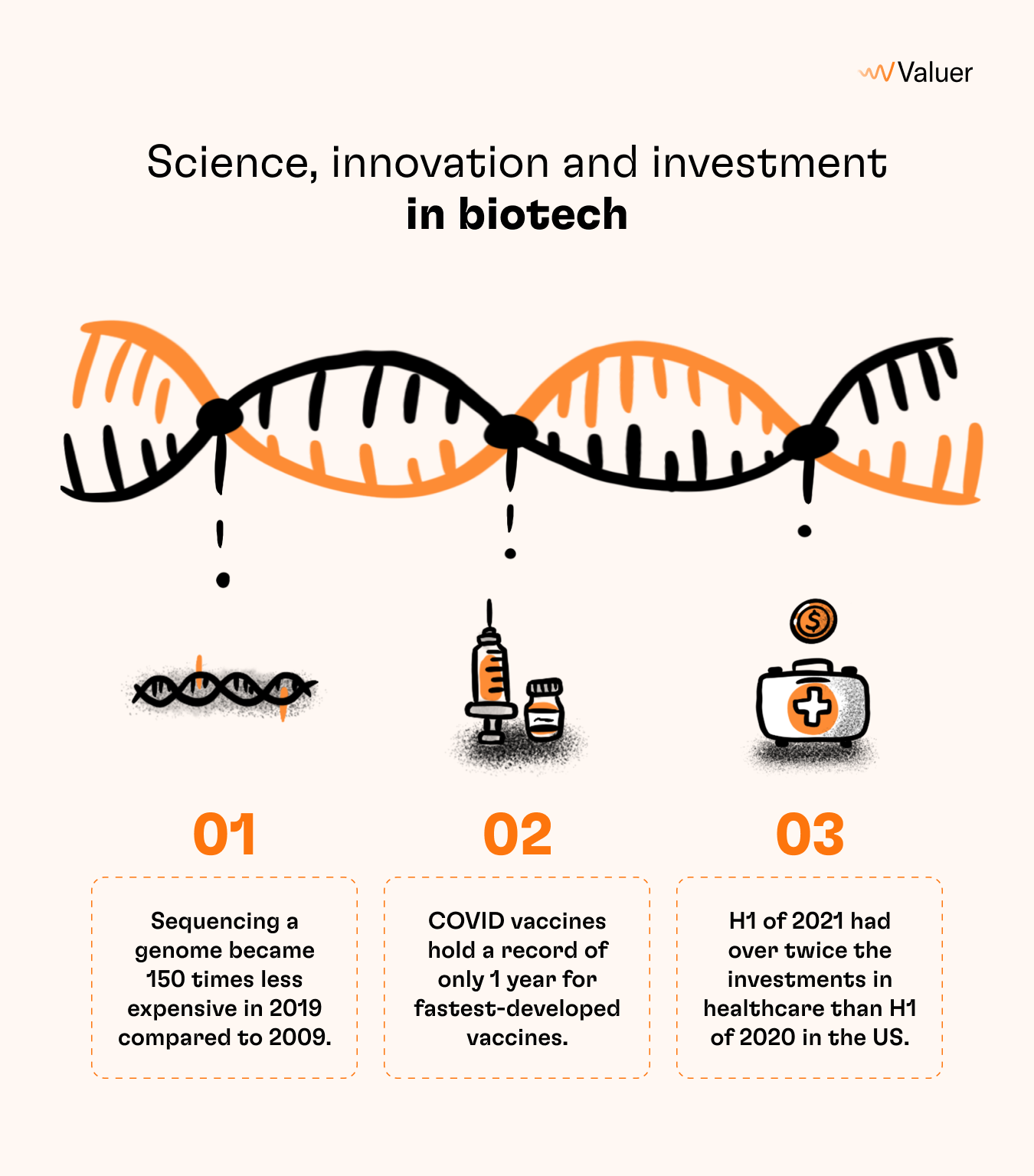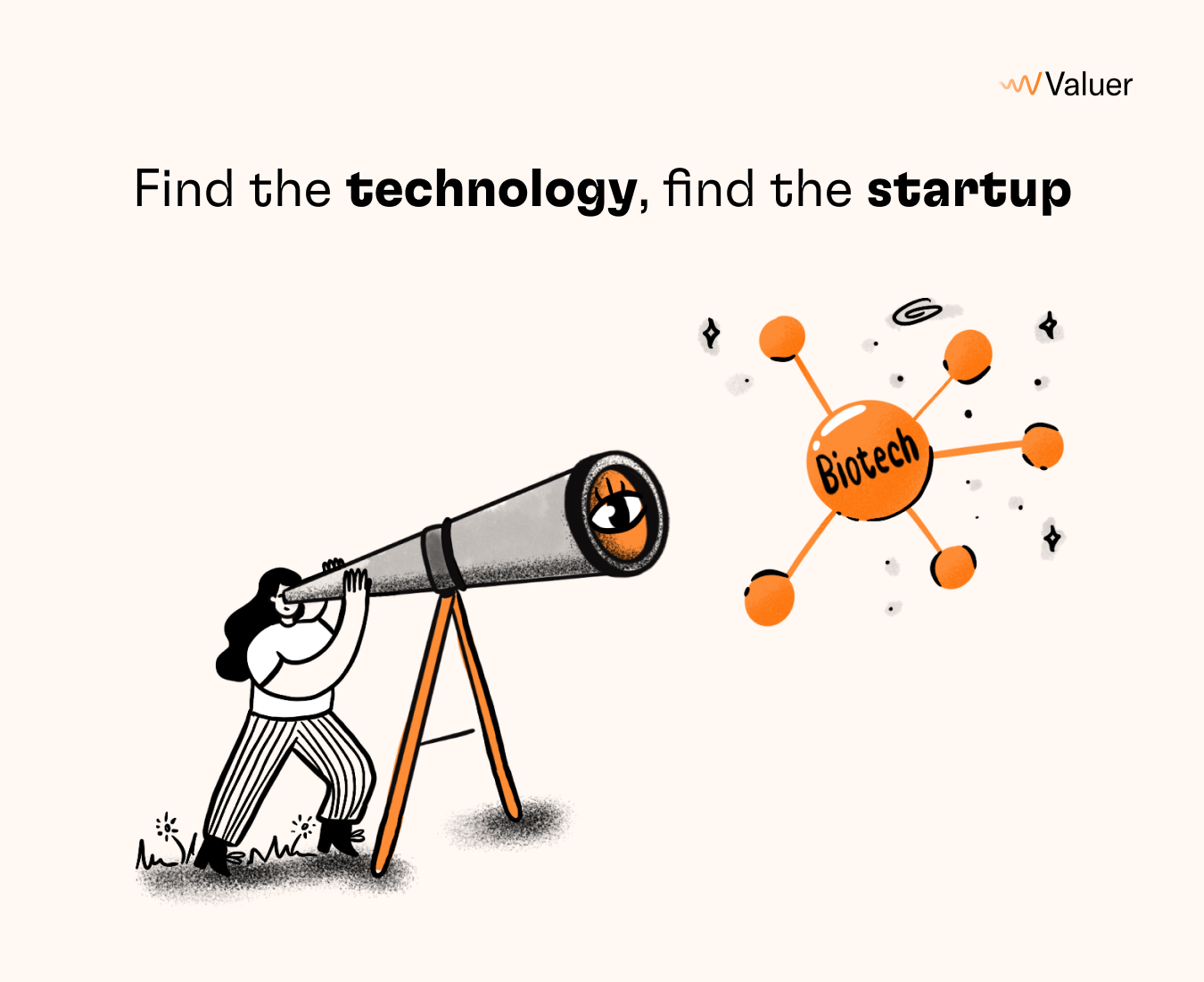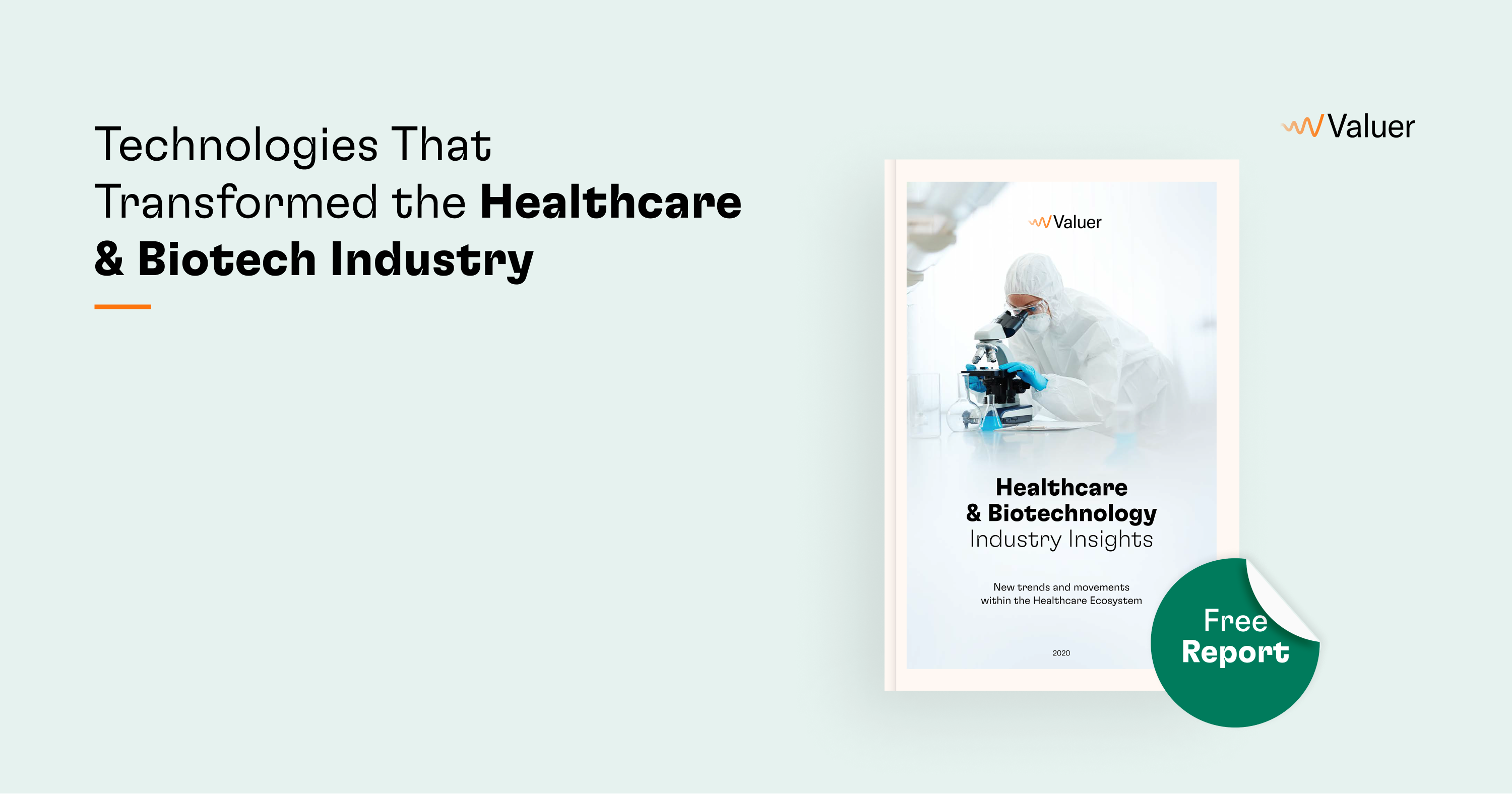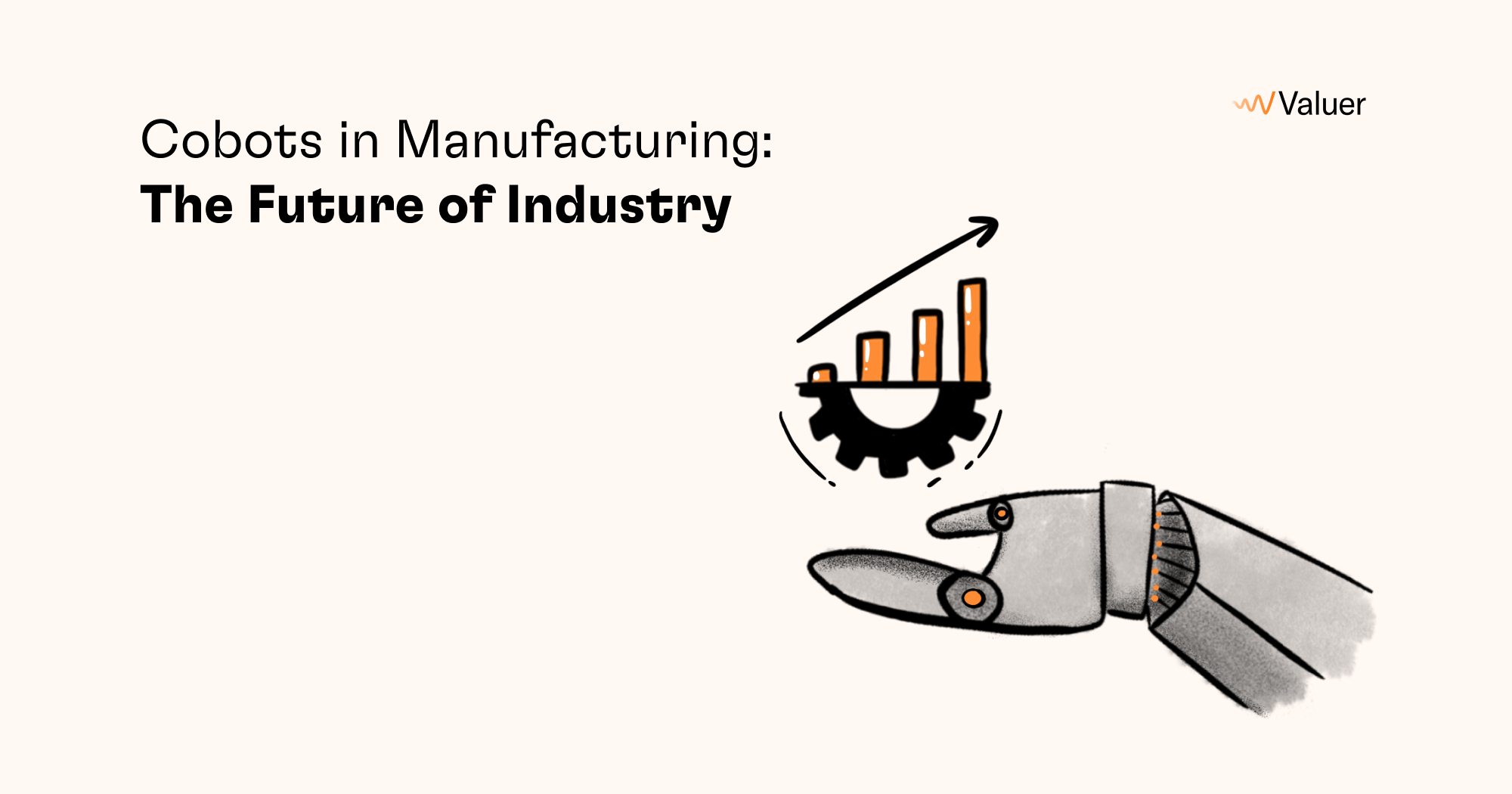*Updated September 2022
Advances in science and biotechnology engineering have paved the way for biotech to become one of the single most relevant industries for the present and the future. The “Bio Revolution” is beyond its nascent stages and is forecasted to truly revolutionize the way we live - eat - heal - even exist. From another vantage point, according to the folks at McKinsey:
“Looking forward, the combination of advances in biological science and accelerating developments in technology and artificial intelligence has the potential to take innovation to a new level.”
All in all, it seems like a great time to get in the game. But investing in biotech is - and always has been - risky business. How can you decide which biotech R&D initiatives are truly worth the trouble? How can you tell the ones that will soar apart from the ones that’ll struggle to get off the ground? We’ll give you tips and tools to increase your chances of finding a gem right after a brief overview of how investments in biotechnology worked in the past and how they work now, in the present.
Investing in biotech in the past decade
Investing in biotech is quite tricky - it’s an industry that is fraught with financial risk and one that takes a long time to provide any sort of ROI for investors. This is especially true for biotech sub-industries like pharmatech.
Back in 2015, Andrew W. Lo and Gary P. Pisano wrote for the MIT Sloan Review that the journey from the initial scientific discovery to a fully approved drug can take anywhere between 10 and 20 years and require over $2 billion in investments. Then, only about 10% of drugs actually get approved by the FDA, and that percentage drops to 7 for categories like oncology.
Another question is - what sort of investor is the biotech sector ideal for? Generally, early-stage development is in the VC field. But even so, VCs traditionally invest in sectors with a faster ROI than pharmaceutical technology, like software. In contrast to the gestation period of drug development, Google was up and running at Stanford a year after its founders started collaborating.
Lo and Pisano argue that the solution to the risk of biotech investments lies in remodeling the way we invest in biotech - or any industry that is high-risk, capital-intensive, and long-term - in the form of PFOs, or project-focused organizations.
In this scenario, investors put money in specific projects, the projects outsource certain sectors, and any owned equipment is upscaled once a project is disbanded and profits are distributed.
Investing in biotech today: How has technology changed the pharmaceutical industry?
On the other hand, a lot of things have changed since 2015. While the premise still holds, the technology grows more sophisticated every year, and some of these processes have been significantly sped up. In pharmatech, for instance, the last decade has been marked by a 60% increase in approved drugs in comparison to the preceding decade. Things like the cost of sequencing a genome became 150 times less expensive in 2019 compared to 2009.
Moreover, the investment in pharmaceutical technology and medical products R&D was the highest of all sectors, even in the pre-pandemic world. During the pandemic, investment in R&D for health saw a 10.3% increase only in the EU and only in 2021. Senior life science commercial strategy consultant Harris Kaplan wrote for Forbes that in his 40 years of experience, he has never seen such an investment climate in the field. He says that:
“Gene and cell therapies, AI, data analytics and a deeper understanding of the relationship between genetics and disease have led to treatments designed specifically for the individual, leading to better outcomes with fewer side effects.”
What does this translate into financially? Well, only the first half of 2021 saw healthcare investment reach $47 billion in the US, more than twice in H1 of 2020, while investments increased from 2019 to 2020 by 50%.
And then, there was another development that changed the speed at which we can expect healthcare technology trends to complete their cycle– the development of COVID vaccines. For starters, it took scientists weeks rather than months to sequence its genome. And vaccine development is a resource-intensive process that typically takes 10-15 years to complete. In the past, the fastest-made vaccine was for mumps in 1967, and that took 4 years.
With COVID-19, Pfizer was approved and ready for use within a year of identifying the virus. Not to mention that we’re talking about a new technology for inoculation - mRNA - which makes it even more amazing that pharmatech hit the mark so quickly. Soon thereafter, the other vaccines became available as well.

In essence, there seems to be a significant acceleration in the ROI that pharmaceutical technology can offer, but this doesn’t mean that safety and quality can or should be rushed. It just means that under special circumstances, we have the brainpower and technology to rise to the challenge, but also that technology has grown sophisticated enough to make more things possible and to change healthcare.
How to find biotechnology trends that are worth investing in
We saw that biotech can be a risky field of investment, which is why when you’re looking to pinpoint the best R&D initiatives and trends in these areas, you’re basically looking for something that shows great promise, the potential to make real change, and - of course - generate returns.
So, what research methods can you rely on to discover the best investment opportunities? Well, let's take a look at four tips, and for each one, explain where Valuer's services can come in and help in this particular area.
1. Stay up to date on trends and technology
The first tip is to keep up to date and on top of current trends in biotechnology and healthcare. However, you also need to identify which trends have a leg to stand on and aren’t just fads, or worse, empty promises. In this sense, it’s also important to know whether the technology is there and the goal is indeed possible. Kaplan warns that “not all sizzle becomes steak,” meaning a lot of noise doesn’t equal great results. Remember the infamous Fyre Festival scandal?
That’s why it’s important to go beyond the noise and dig deeper. In this sense, you want to be up-to-date on the less noisy trends that quietly make their way to the light of day.
How Valuer can keep you in the loop on biotechnology trends
Our technologies feature contains a list of technologies that are trending, poised for success, and in a nutshell - likely to be a part of a better future. Each technology has its own overview and a list of startups that employ or develop that tech.
Some biotechnology-related fields you can find on our platform:
What’s more, once you’ve selected a technology, you can filter the results, i.e., startups using that technology, based on your preferences. For instance, we looked for cultured meat startups and added a filter that specified they were founded after 2017. Two of the many results were Meatable and Novel Farms, Inc.

You can also order a bespoke technology deep dive, and our research team will provide you with a resourceful report on everything you need to know about the technology you're looking into - how it works, where it’s at, who uses it, trends, etc.
2. Stay on top of sub-industries
Biotech is a very broad field, and new pieces of technology may find a home, i.e., application, in the various biotech sub-industries. That’s why you need to not only stay on top of new biotechnology trends but also which specific sectors it would be best suited for in terms of efficacy, results, growth, etc.
A McKinsey study from 2020 found that in the future, as much as 60% of physical inputs to the global economy could be produced biologically. This includes agricultural products like cultured meat, healthcare/pharmaceutical technologies and products, energy from biowaste, construction materials, etc. And the various sub-sectors of biotech, like biomolecules and biosystems interact and help each other grow.
That’s why staying aware of how the different fields are interconnected in biotech and what startups utilize a certain conglomeration of technologies could help you decide where to invest in biotech. But constantly doing independent research to find up-and-comers in these sub-industries is quite arduous. Luckily, there are tools that can help.
How Valuer can help you track sub-industries
Valuer’s industries feature contains various industries and how that industry is made up their respective sub-industries. Biotechnology is one of the industries covered by the platform. Now, what the industry clusters tool allows you to do is visualize how the sub-industries overlap using biotech startups.
Each sub-industry is color-coded and reflected in the dots that represent individual companies. The spatial distribution of the dots - or companies - allows you to determine how similar or different they are from each other.
All the Biotechnology sub-industries that are currently available include:
- Bioinformatics
- Biometrics
- Biopharma
- Genetics
- Life Science
- Neuroscience
- Quantified Self
- Microbiome
- Microbiology
- Medical Devices
- Precision Medicine
Also, you can further narrow down results using filters. For instance, we selected only biopharma companies and further filtered the results to only reflect startups founded after 2020. These results included Cell BioEngines and Known Medicine.
3. Communicate with universities– the beacons of innovation
A lot of startups begin their journeys in university projects. This is especially the case when it comes to something like biotechnology engineering, which you can’t exactly launch in your parents’ garage. Big corporate investors like Atlas Venture, RA Capital, Third Rock, Venrock, ARCH, etc., and philanthropists often fund and cofound startups that arise directly from universities - so-called “university spinouts.”

But before you can decide that a project focused on developing a certain technology is a good investment choice, you need to understand the tech, its potential, and its applications.
How Valuer can help you understand emerging biotechnology trends
As we already mentioned, you can order a technology deep dive that will fill you in on the way it works and how it’s being developed. Having a better understanding of the scope and stage that the tech is in can help you evaluate a certain startup - or in this case, a university spin-out - more accurately. This is what we call an actionable insight, and it can make the difference between sinking or swimming.
4. Know everything there is to know about a biotech startup and its market before you invest
In some ways, certain startups almost act like project-focused organizations because they are founded around the development of a particular product or service. That’s what makes the ground a bit uncertain for investing in biotech startups. On one hand, if you invest early, you’re more likely to get good returns if everything goes to plan. On the other hand, you can’t be sure of the chances of success.
The very first thing Kaplan says investors should look out for is the status of the product. What stage of development is it in? Will it pass regulatory approval? Is there demand in the market for that specific product?
How Valuer can provide you with detailed information about startups
OK, so we already established why it’s important to know as much as you can about the technology. Well, the same is true of a startup. A good idea is simply not enough. You also need solid execution, realistic goals, and achievable milestones along the way.
When you look at biotech startups or any startup for that matter on our platform, you already get various details on their profiles - like their stage of development, funding, team size, year of inception, website, etc. This is a good starting point to see if some of your priorities are aligned. However, if you want all the ins and outs and inside scoops and market promises of a certain startup, then you can submit a research request. Our team will prepare a custom report on that particular company.
What’s more, if you really like a particular company, you can use our look-alikes tool to find startups with similar products and see if they meet your expectations. For instance, we looked for biotech startups that are similar to Mosa Meat, the first company that introduced cultured meat to the world in 2013. We got a full list of startups, including SGProtein, Gaia Foods, and Micro Meat.
Investing in biotech is investing in the future
Hopefully, our tips and tools will be useful in your search for the best R&D initiatives in biotech. Whether you’re only interested in biotechnology trends or looking to jump into the next disruptive technology in the industry, our platform can help you get there.
Biotech is a complex and broad industry, so exploring it requires a combination of deep insights and understanding, precise data on the startup ecosystem, and enough room for customization so that you can get from the very general to the very specific.
What our platform is designed to do is offer all of the above. If you're curious about what the full potential of the platform and the various services we provide can do for your initiatives, take a spin using our 14-day free trial. You may just realize it's a great way to get all the in-depth data you need in one spot.
.png?width=103&height=103&name=Untitled_Artwork%20725%20(2).png)









